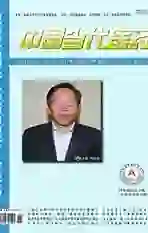小儿气管异物取出术中两种不同麻醉方法的比较
2014-06-12史素丽陈永彦李玮
史素丽 陈永彦 李玮
[摘要] 目的 对比研究气管异物取出术的两种麻醉方法,以找出更快速、安全、有效的麻醉方法。 方法 选取就诊于本院行气管异物取出术的患者,将其随机分为两组,保留自主呼吸组A组,复合肌松药麻醉机控制通气组B组。A组:入室后常规监测,给予面罩纯氧吸入。依次静脉注射咪达唑仑、依托咪酯、瑞芬太尼,并置入喉镜喷入利多卡因对气道黏膜进行表面麻醉,维持麻醉用瑞芬太尼、丙泊酚。手术时通过气管镜侧孔持续供氧。B组在A组麻醉诱导的基础上静脉注射琥珀胆碱。手术开始后麻醉机连接气管镜侧孔,以压力通气模式控制呼吸。术毕,面罩辅助呼吸,待患儿自主呼吸正常,完全清醒后送回病房。记录手术时间、钳夹异物次数、血氧饱和度低需要中断手术供氧次数,面罩吸氧时和钳取异物时的血气分析指标。 结果 B组的手术时间短于A组,钳夹次数、手术中断次数少于A组(P<0.05);T2时,B组氧合较A组好(P<0.05),术中B组SpO2较A组高,心率和血压较A组低(P<0.05)。 结论 复合肌松药静脉全身麻醉在麻醉机控制下,通过侧孔控制通气可以保证患者术中的氧供,比传统的保留自主呼吸的麻醉方法有很多方面的优势。
[关键词] 小儿气管异物;两种麻醉方法;比较
[中图分类号] R614.2+4 [文献标识码] A [文章编号] 1674-4721(2014)04(b)-0095-03
[Abstract] Objective To compare and research two different methods of anesthesia in the removal operation of tracheal foreign body to find a swift,safe and effective method of anesthesia. Methods Patients treated in our hospital with the removal operation of tracheal foreign body were selected and randomly divided into the two groups,the group A was retained spontaneous breathing,the group B was compound muscle relaxant anesthesia machine controling ventilation group.The group A was monitored regularly after admitting room and given pure oxygen inhalation through mask,general anesthesia was induced with midazolam,etomidate,remifentanil.Laryngoscope was inserted and lidocaine was spurted to do surface anesthesia in the airway mucosal.Anesthesia was maintained with remifentanil and propofol.Oxygen was keeping inhalation through the bronchoscope side opening during operation.Based on the induction of anesthesia of the group A,succinylcholine was intravenous injected.After the start of operation,anesthesia machine connected to the bronchoscope side opening,and the children breathing was controlled with pressure ventilation mode.At the end of the operation,face mask assisting respiration,when patients breathed normally,fully awaked and they were sent to the ward.The operating time,the number of times for foreign body clamped,the times of interrupting the operation for lower oxygen saturation,blood gas analysis index of during mask oxygen and removal of foreign body were recorded. Results The operative time in the group B was shorter than that in the group A,clamping times and the frequency of interrupting surgery in the group B wasfewer than that in the group A(P<0.05);oxygenation of the group B was better than that of the group A (P<0.05);SpO2 of the group B was higher than that of the group A, heart rate and blood pressure was lower than that of the group A (P<0.05). Conclusion Intravenous general anesthesia compositing muscle relaxants under controlled by anesthesia machine through lateral aperture of bronchoscope to control ventilationcan guarantee the oxygen supply of patients during operation,and it hasmany advantages compared with traditional anesthesia method of with spontaneous breathing.
[Key words] Pediatric tracheal foreign body;Two anesthetic methods;comparison
气管异物取出术是很常见的小儿急诊手术,同时又是风险性极大的手术,常合并较严重的呼吸道并发症,包括肺炎、肺不张、支气管扩张或肺脓肿[1]。气管异物取出术可导致严重窒息甚至死亡,所以必须行急诊手术取出异物。小儿气管异物取出术的麻醉是一类高风险、高难度的麻醉。合适的全身麻醉方式,可为手术创造安全有效的条件,麻醉不当可引起严重的并发症[2],因而如何合理地调控麻醉深度、加强呼吸道管理、减少围术期并发症成为该类手术麻醉处理的关键。目前主要有两种麻醉方法,一是保留自主呼吸的全身麻醉方法,二是使用肌松药并用麻醉机控制呼吸的全身麻醉方法。本研究对这两种方法进行对比研究,以找出更快速、安全、有效的麻醉方法。
1 资料与方法
1.1 一般资料
选取2012年5月~2012年12月就诊于本院行气管异物取出术的患者72例,男性41例,女31例,年龄7个月~10岁,体重8~26 kg,ASAⅠ~Ⅱ级。异物为花生米、瓜子、大豆、笔帽等。异物留置时间为数小时至20 d。将患者随机分为两组,每组各36例,保留自主呼吸组(A组),复合肌松药并用普通麻醉机控制通气组(B组)。A组:男性20例,女性16例,年龄(14.3±3.5)个月,体重为(8.35±2.13)kg,病程为(3.5±2.3)d;B组:男性21例,女性15例,年龄(13.6±4.2)个月,体重为(8.27±1.72)kg,病程为(2.9±1.7)d。
两组患者的性别、年龄、体重、ASA分级、异物性质、病程比较,差异无统计学意义(P>0.05)。
1.2 麻醉方法
患儿术前30 min均肌内注射阿托品0.01~0.02 mg/kg。A组入室后连续监测心率(HR)、血氧饱和度(SpO2)及心电图,面罩纯氧吸入。依次缓慢静脉注射咪达唑仑0.05~0.1 mg/kg、依托咪酯0.3 mg/kg,患儿入睡后静脉注射瑞芬太尼1.5 μg/kg(注射时间>1 min);维持瑞芬太尼0.1 μg/(kg·min),丙泊酚6~8 mg/(kg·h)。置入喉镜暴露声门置入喉麻管,向气管内喷入2%利多卡因(0.1 ml/kg)对隆突黏膜进行表面麻醉。1 min后置入支气管镜,通过气管镜测孔持续供氧,如术中出现SpO2下降(<90%),嘱术者支气管镜退至主气道。仍然<90%时应退出支气管镜,面罩加压通气至SpO2>95%后再重新置镜。B组在A组麻醉诱导的基础上静脉注射琥珀胆碱2 mg/kg,手术开始后麻醉机连接气管镜侧孔,压力通气模式,频率为50~60次/min,压力为50~60 cm H2O,新鲜气流6~8 L/min(通过试验表明氧气进入气道的实际压力<25 cm H2O)。术毕,面罩辅助呼吸,待患儿自主呼吸正常,血氧饱和度>94%,完全清醒后送回普通病房。
1.3 观察指标
手术时间;钳夹异物次数;SpO2<90%,时间>10 s,需要中断手术供氧次数;麻醉面罩吸氧时(T1)和钳取异物时(T2)的血气分析指标。
1.4 统计学处理
采用SPSS 13.0软件进行数据分析,计量资料以均数±标准差(x±s)表示,组间比较采用t检验,以P<0.05为差异有统计学意义。
2 结果
两组手术均成功,患儿于麻醉后监测治疗室(PACU)清醒,SpO2>94%,安全送返病房。
2.1 两组手术情况的比较
B组的手术时间短于A组,钳夹次数、手术中断次数少于A组(P<0.05)(表1)。
3 讨论
小儿气管异物是临床常见急症,患儿大多有严重凹陷性呼吸困难,低氧血症,并常合并呼吸道炎症,成为应激性气道,麻醉风险很大,处理不当很容易发生严重并发症,甚至死亡[3]。异物取出术中手术操作与麻醉通气共用同一气道,极易使患者术中缺氧、二氧化碳积聚,而通过血气分析可以真实地反映患者的术中通气状况。Soodan等[4]报道吸入氟烷保留自主呼吸组因为低氧血症和不适宜的麻醉深度,不得不进行辅助通气,而且咳嗽和呛咳的发生率明显高于控制呼吸组。Litman等[5]回顾性分析94例气管异物取出术病例,其中16例因为通气不足、体动、喉痉挛等原因而不得不自主(或辅助)通气改为给肌松药后控制通气。
从本研究来看,保留自主呼吸的麻醉方法有较多弊端,手术刺激强度大,麻醉深浅不易掌握,麻醉过浅,术中易发生屏气、呛咳、支气管痉挛等并发症,从而引起通气不足,低氧血症,手术操作准确性降低,手术时间延长,甚至使气道造成损伤;麻醉过深,易致呼吸抑制,从而造成缺氧等严重后果,必须紧急采取手控呼吸。复合肌松药静脉全身麻醉下通过侧孔麻醉机控制通气的情况下可以较好地保证患者术中的氧供,麻醉师对呼吸道的管理更加从容,手术医生操作更加稳定而快捷。本研究结果显示,采用麻醉机维持术中患者氧供比传统的保留自主呼吸的麻醉方法有很多方面的优势,而此方法即是高频通气机应用原理,从而为没有高频通气机的医院提供一个参考。本文应用两种麻醉方法皆较顺利地完成手术,手术效果良好,无严重并发症发生,但有学者提出过不论是硬支气管镜下的异物取出、支架置入,还是各种硬支气管镜下的气道腔内治疗,其通气方法的选择始终是困扰临床的一大难题,任何一种通气模式都很难满足患者的通气需要,难以维持足够的SpO2,并常常伴有严重的二氧化碳潴留[6]。通过硬质支气管镜侧孔行高频喷射通气,当异物存在于支气管时,支气管镜伸入患侧支气管可导致健侧肺不能进行有效通气,易发生缺氧[7]。不论采用何种麻醉方式,术中及术后均需加强监测尤其是血氧饱和度的监测,防止缺氧发生[8-11]。我们在临床工作中的体会:异物在主气道缺氧不可避免;异物在一侧支气管用目前的通气方法也不能始终保持完善的氧气供给,说明此类手术麻醉控制通气也有一定的不足之处,仍需要进一步探讨更为合适的麻醉方法及通气方式,我们在临床工作中正在进一步研究。
[参考文献]
[2] Tomaske M,Gerber AC,Weiss M.Anesthesia and periinterventional morbidity of rigid bronchoscopy for tracheobronchial foreign body diagnosis and removal[J].Paediatr Anaesth,2006,16(2):123-129.
[3] 蒋静敏.江春秀.小儿气管异物取出术死亡的教训[J].临床麻醉学杂志,1994,10(5):282.
[4] Soodan A,Pawar D,Subramanium R.Anesthesia for removal of inhaled foreign bodies in children[J].Paediatr Anaesth,2004,14(11):947-952.
[5] Litman RS,Ponnuri J,Trogan I.Anesthesia for tracheal or bronchial foreign body removal in children:ananalysis of ninety-fourcases[J].Anesth Analg,2000,91(6):1389-1391.
[6] Fernandez-Bustamante A,Iba?觡ez V,et al.High-frequencyjet ventilation in interventional bronchoscopy:factors with predictive value on high-freguency jet ventilation complications[J].J Clin Anesth,2006,18(5):349-356.
[7] 张继壮,刘树新,左晶晶.单独持续输注瑞芬太尼用于老年高血压患者纤维支气管镜检术清醒镇静的临床探讨[J].西部医学,2014,26(2):178-181.
[8] Tan HK,Tan SS.Inhaled foreign bodies in children—anaesthetic considerations[J].Singapore Med J,2000,41(10):506-510.
[9] 王国平,刁枢.全麻中应用帕瑞昔布钠对术后苏醒的影响[J].实用中西医结合临床,2012,12(6):69-70.
[10] 吴祖明,刘雨峰.罗哌卡因配伍舒芬太尼用于前列腺手术的麻醉体会[J].实用中西医结合临床,2012,12(4):86-87.
[11] 黎洪林.椎管内麻醉并发下肢疼痛与功能障碍的原因及治疗[J].中国医药科学,2013,3(24):108-109.
(收稿日期:2013-12-30 本文编辑:许俊琴)
[参考文献]
[2] Tomaske M,Gerber AC,Weiss M.Anesthesia and periinterventional morbidity of rigid bronchoscopy for tracheobronchial foreign body diagnosis and removal[J].Paediatr Anaesth,2006,16(2):123-129.
[3] 蒋静敏.江春秀.小儿气管异物取出术死亡的教训[J].临床麻醉学杂志,1994,10(5):282.
[4] Soodan A,Pawar D,Subramanium R.Anesthesia for removal of inhaled foreign bodies in children[J].Paediatr Anaesth,2004,14(11):947-952.
[5] Litman RS,Ponnuri J,Trogan I.Anesthesia for tracheal or bronchial foreign body removal in children:ananalysis of ninety-fourcases[J].Anesth Analg,2000,91(6):1389-1391.
[6] Fernandez-Bustamante A,Iba?觡ez V,et al.High-frequencyjet ventilation in interventional bronchoscopy:factors with predictive value on high-freguency jet ventilation complications[J].J Clin Anesth,2006,18(5):349-356.
[7] 张继壮,刘树新,左晶晶.单独持续输注瑞芬太尼用于老年高血压患者纤维支气管镜检术清醒镇静的临床探讨[J].西部医学,2014,26(2):178-181.
[8] Tan HK,Tan SS.Inhaled foreign bodies in children—anaesthetic considerations[J].Singapore Med J,2000,41(10):506-510.
[9] 王国平,刁枢.全麻中应用帕瑞昔布钠对术后苏醒的影响[J].实用中西医结合临床,2012,12(6):69-70.
[10] 吴祖明,刘雨峰.罗哌卡因配伍舒芬太尼用于前列腺手术的麻醉体会[J].实用中西医结合临床,2012,12(4):86-87.
[11] 黎洪林.椎管内麻醉并发下肢疼痛与功能障碍的原因及治疗[J].中国医药科学,2013,3(24):108-109.
(收稿日期:2013-12-30 本文编辑:许俊琴)
[参考文献]
[2] Tomaske M,Gerber AC,Weiss M.Anesthesia and periinterventional morbidity of rigid bronchoscopy for tracheobronchial foreign body diagnosis and removal[J].Paediatr Anaesth,2006,16(2):123-129.
[3] 蒋静敏.江春秀.小儿气管异物取出术死亡的教训[J].临床麻醉学杂志,1994,10(5):282.
[4] Soodan A,Pawar D,Subramanium R.Anesthesia for removal of inhaled foreign bodies in children[J].Paediatr Anaesth,2004,14(11):947-952.
[5] Litman RS,Ponnuri J,Trogan I.Anesthesia for tracheal or bronchial foreign body removal in children:ananalysis of ninety-fourcases[J].Anesth Analg,2000,91(6):1389-1391.
[6] Fernandez-Bustamante A,Iba?觡ez V,et al.High-frequencyjet ventilation in interventional bronchoscopy:factors with predictive value on high-freguency jet ventilation complications[J].J Clin Anesth,2006,18(5):349-356.
[7] 张继壮,刘树新,左晶晶.单独持续输注瑞芬太尼用于老年高血压患者纤维支气管镜检术清醒镇静的临床探讨[J].西部医学,2014,26(2):178-181.
[8] Tan HK,Tan SS.Inhaled foreign bodies in children—anaesthetic considerations[J].Singapore Med J,2000,41(10):506-510.
[9] 王国平,刁枢.全麻中应用帕瑞昔布钠对术后苏醒的影响[J].实用中西医结合临床,2012,12(6):69-70.
[10] 吴祖明,刘雨峰.罗哌卡因配伍舒芬太尼用于前列腺手术的麻醉体会[J].实用中西医结合临床,2012,12(4):86-87.
[11] 黎洪林.椎管内麻醉并发下肢疼痛与功能障碍的原因及治疗[J].中国医药科学,2013,3(24):108-109.
(收稿日期:2013-12-30 本文编辑:许俊琴)
